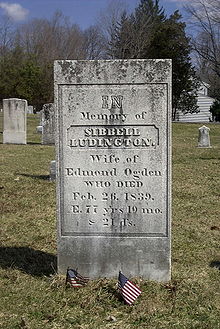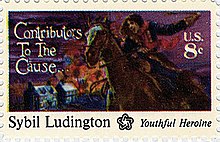Sybil Ludington: Difference between revisions
JamesMoose (talk | contribs) rv |
No edit summary |
||
| Line 7: | Line 7: | ||
==The Ride== |
==The Ride== |
||
Ludington's ride started at 9:00 P.M. and ended around dawn.<ref name="historicsybil">[http://www.historicpatterson.org/Exhibits/ExhSybilLudington.php Historic Patterson, New York - Sybil Ludington]</ref> She rode 40 miles, more than twice the distance of Paul Revere, into the damp hours of darkness. She rode through [[Carmel, New York|Carmel]] on to [[Mahopac, New York|Mahopac]], thence to [[Kent Cliffs, New York|Kent Cliffs]], from there to [[Farmers Mills, New York|Farmers Mills]] and back home. She used a stick to prod her horse and knock on doors. She managed to defend herself against a highwayman with |
Ludington's ride started at 9:00 P.M. and ended around dawn.<ref name="historicsybil">[http://www.historicpatterson.org/Exhibits/ExhSybilLudington.php Historic Patterson, New York - Sybil Ludington]</ref> She rode 40 miles, more than twice the distance of Paul Revere, into the damp hours of darkness. She rode through [[Carmel, New York|Carmel]] on to [[Mahopac, New York|Mahopac]], thence to [[Kent Cliffs, New York|Kent Cliffs]], from there to [[Farmers Mills, New York|Farmers Mills]] and back home. She used a stick to prod her horse and knock on doors. She managed to defend herself against a highwayman with a long stick. When, soaked with rain and exhausted, she returned home, most of the 400 soldiers were ready to march.<ref name ="sybilgravedata">[http://www.findagrave.com/cgi-bin/fg.cgi?page=gr&GRid=2539 Sybil Ludington ]</ref><ref name ="Sybil Ludington: a Revolutionary Hero">[http://traverseforwomen.com/Herstory/SybilLudington.htm Sybil Ludington: a Revolutionary Hero]</ref> |
||
The memoir for Colonel Henry Ludington states, |
The memoir for Colonel Henry Ludington states, |
||
Revision as of 01:53, 19 February 2013

Sybil Ludington (April 5, 1761 – February 26, 1839), daughter of Colonel Henry Ludington, was a heroine of the American Revolutionary War who became famous for her night ride on April 26, 1777 to alert American colonial forces to the approach of the British. Her action was similar to that performed by Paul Revere,[1][2][3][4][5] though she rode more than twice the distance of Revere and was only 16 years old at the time of her action. She was an aunt of Harrison Ludington, the Governor of Wisconsin.
Childhood
Sybil (who was born on the 5th of April 1761) was the oldest of twelve children. Her father’s name was Henry who was a colonel in the French & Indian War in 4/10/1756. Her mother’s name was Abigail Ludington.
The Ride
Ludington's ride started at 9:00 P.M. and ended around dawn.[6] She rode 40 miles, more than twice the distance of Paul Revere, into the damp hours of darkness. She rode through Carmel on to Mahopac, thence to Kent Cliffs, from there to Farmers Mills and back home. She used a stick to prod her horse and knock on doors. She managed to defend herself against a highwayman with a long stick. When, soaked with rain and exhausted, she returned home, most of the 400 soldiers were ready to march.[7][8]
The memoir for Colonel Henry Ludington states,
Sybil, who, a few days before, had passed her sixteenth birthday, and bade her to take a horse, ride for the men, and tell them to be at his house by daybreak. One who even now rides from Carmel to Cold Spring will find rugged and dangerous roads, with lonely stretches. Imagination only can picture what it was a century and a quarter ago, on a dark night, with reckless bands of "Cowboys" and "Skinners" abroad in the land. But the child performed her task, clinging to a man's saddle, and guiding her steed with only a hempen halter, as she rode through the night, bearing the news of the sack of Danbury. There is no extravagance in comparing her ride with that of Paul Revere and its midnight message. Nor was her errand less efficient than his. By daybreak, thanks to her daring, nearly the whole regiment was mustered before her father's house at Fredericksburgh, and an hour or two later was on the march for vengeance on the raiders.[1]
The men arrived too late to save Danbury, Connecticut. At the start of the Battle of Ridgefield, however, they were able to drive General William Tryon, then governor of the colony of New York, and his men to Long Island Sound.[7][8]
Sybil was congratulated for her heroism by friends and neighbors and also by General George Washington.[7][9][10][11][12] [13][14][15][16]


After the war, in 1784, "when she was twenty-three years old, Sybil Ludington married Edmund Ogden, with whom she had one child named Henry. Her son had 6 children not her. . Edmund was a farmer and innkeeper, according to various reports. In 1792 Sybil settled with her husband and six children in Catskill, where they lived until her death on February 26, 1839, at the age of 77. She was buried near her father in the Patterson Presbyterian Cemetery in Patterson, New York.[6] Her tombstone, at right, shows a different spelling of her first name.
In 1935 New York State erected a number of markers along her route. A statue of Sybil, sculpted by Anna Hyatt Huntington, was erected near Carmel, New York, in 1961 to commemorate her ride. Smaller statues[17] of the statue exist on the grounds of the Daughters of the American Revolution Headquarters in Washington, DC; on the grounds of the public library, Danbury, Connecticut; and in the Elliot and Rosemary Offner museum at Brookgreen Gardens, Murrells Inlet, South Carolina.

In 1975 Sybil Ludington was honored with a postage stamp in the "Contributors to the Cause" United States Bicentennial series.[6][7]
Each April since 1979, the Sybil Ludington 50-kilometer footrace has been held in Carmel, New York. The course of this hilly road race approximates Sybil's historic ride, and finishes near her statue on the shore of Lake Gleneida, Carmel, New York.[7]
Sources
- Binkley, Marilyn R., Reading Literacy in the U.S.: Findings from the IEA Reading Literacy Study, DIANE Publishing, 1996, ISBN 0-7881-4512-6
- Bohrer, Melissa Lukeman, Glory, passion, and principle: the story of eight remarkable women at the core of the American Revolution, Simon and Schuster, 2003, ISBN 0-7434-5330-1
- Johnson, Willis Fletcher (1907). Colonel Henry Ludington: A Memoir. Connecticut: self-published. Retrieved March 24, 2010.
{{cite book}}: Cite has empty unknown parameter:|coauthors=(help) - Miller, Brandon Marie, Growing up in revolution and the new nation, 1775 to 1800, Lerner Publications, 2003, ISBN 0-8225-0078-7
- Moore, David W., Developing readers and writers in the content areas K-12, Pearson/Allyn and Bacon, 2006,ISBN 0-205-49474-9
- Weatherford, D., Milestones : A chronology of American women's history. New York: Facts on File, 1997, ISBN 0-8160-3200-9
Footnotes
- ^ a b Johnson, "Memoir," Colonel Henry Ludington, Google Books
- ^ It was first mentioned by Lewis S. Patrick (Connecticut historian and Ludington descendant, great nephew of Sybil Ludington) in The Connecticut Magazine II (no. 2, 1907) and credit was given to Patrick by Willis Fletcher Johnson in the memoirs of Colonel Henry Ludington. Hauntings of the Hudson River Valley: An Investigative Journey By Vincent T. Dacquino, p. 93</ ref name ="news08152009">Ludington Daily News front page, Saturday, August 15, 2009
- ^ Ludington - American Revolutionary War heroine, remembered for her valiant role in defense against British attack
- ^ Sybil's Story, footnotes 20, 21, 23
- ^ American National Biography Online - Sybil Ludington
- ^ a b c Historic Patterson, New York - Sybil Ludington
- ^ a b c d e Sybil Ludington
- ^ a b Sybil Ludington: a Revolutionary Hero
- ^ Sybil Ludington article by Jone Johnson Lewis
- ^ Sybil Ludington - Her Midnight Ride
- ^ Miller, p. 18, Later, America's general George Washington came to Sybil's house to thank her.
- ^ Moore, p. 300, Afterward, General George Washington made a personal visit to Ludington's Mills to thank Sybil for her courageous deed.
- ^ Macmillan/McGraw-Hill, Biography - Sybil Ludington 1761—1839, Unit 3, Chapter 5, The American Revolution Later, Sybil was thanked personally by General George Washington.
- ^ Binkley, p. 18, Afterward, General George Washington made a personal visit to Ludington's Mill to thank Sybil for her courageous deed.
- ^ Smithsonian Source - Confirmation Readings (Sybil Ludington)
- ^ Weatherford, p. 31, ... After the battle at Danbury, George Washington and French General Rochambeau came to the Ludington home to thank Sybil.
- ^ "Original" defined as a sculpture cast under the supervision of original artist during his/her lifetime.
